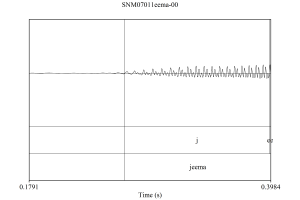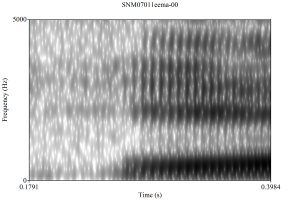For this essay, I take “Okinawan” to mean South-Central Okinawan, the varieties spoken on the southern and central portion of Okinawa Island (沖縄本島 Okinawa-hontō), and surrounding smaller islands like Kume Island (久米島 Kume-jima). This is distinct from the Kunigami varieties spoken on the northern portion of Okinawa Island. Borrowing from South-Central Okinawan varieties into Kunigami varieties means that there is no discrete line between what is Okinawan and what is Kunigami. The inverse also appears to occur, though it is less clear if this is actually borrowing from Kunigami varieties, retention of Kunigami features by otherwise Okinawan-ified Kunigami varieties, or a mix of both.
For the purposes of this essay, I take the dividing line between Kunigami and South-Central Okinawan to be the Ishikawa Isthmus, the narrow portion of land running from Ishikawa City (石川市 Ishikawa-shi) in the south, to Nago City (名護市 Nago-shi) in the north. I take varieties spoken on the Ishikawa Isthmus to be a part of the Kunigami dialect group, while varieties south of isthmus to belong to the South-Central Okinawan dialect group. So Yomitan is a South-Central Okinawan variety, while Kin is a Kunigami variety.
Population counts, and percentages, of people binned into age 40 and over, age 50 and over, and age 65 and over can be found in table 1 and 2, respectively.
| Location | Total pop. | Over 40 | Over 50 | Over 65 |
|---|---|---|---|---|
| Ginowan | 91,928 | 42,824 | 29,593 | 13,428 |
| Itoman | 57,320 | 28,152 | 21,151 | 9,480 |
| Naha | 315,945 | 163,334 | 116,143 | 55,644 |
| Nakagami Dist. | 147,688 | 72,295 | 52,699 | 24,628 |
| Nanjō | 39,758 | 21,892 | 17,160 | 8,415 |
| Okinawa | 130,249 | 61,726 | 43,927 | 20,137 |
| Shimajiri Dist. | 94,783 | 47,997 | 36,156 | 16,796 |
| Tomigusuku | 57,261 | 26,024 | 18,708 | 8,241 |
| Urasoe | 110,351 | 51,811 | 35,830 | 15,846 |
| Uruma | 116,979 | 58,191 | 43,531 | 20,445 |
| Totals | 1,162,262 | 574,246 | 414,898 | 193,060 |
| Location | Pct. over 40 | Pct. over 50 | Pct. over 65 |
|---|---|---|---|
| Ginowan | 46.6% | 32.2% | 14.6% |
| Itoman | 49.1% | 37.0% | 16.5% |
| Naha | 51.7% | 36.8% | 17.6% |
| Nakagami Dist. | 49.0% | 35.7% | 16.7% |
| Nanjō | 55.1% | 43.2% | 21.2% |
| Okinawa | 47.4% | 33.7% | 15.5% |
| Shimajiri Dist. | 50.6% | 38.1% | 17.7% |
| Tomigusuku | 45.4% | 32.7% | 14.4% |
| Urasoe | 47.0% | 32.5% | 14.4% |
| Uruma | 49.7% | 37.2% | 17.5% |
| Totals | 49.4% | 35.7% | 16.6% |
(1) y = 2x – 40
Where x is a given age (in years), and y is the percentage of speakers that age able to speak the language. This is, of course, and overly simplified model. We would likely be better off using a slightly more complex model, like the one found in Abrams and Strogatz 2003, which models language competition between a pair of languages, based on the proportion of speakers of each language, as well as the relative prestige of each language (Abrams and Strogatz 2003: 900). For our estimate, though, we will simply use the simple linear model.
With this simple linear model, again returning to Japanese census data for the same areas as above, we arrive at a number of a little less that 490,552 people. As this simple linear regression model provides a poor estimate of the proportion of Okinawan speakers, we can probably conclude that this number is an overestimate of the true number of Okinawan speakers. A more aggressive decline, with no speakers under the age of 41, as defined in (2), leaves 334,457 people who can speak Okinawan.
(2) y = 10/3x – 400/3
Again, both (1) and (2) are overly simplified models. We would be better off with a more slightly more nuanced model, but this is a good first approximation. So we can say, with reservations, that around 400,000 people in southern and central Okinawa and its environs (or approximately 34.4% of people living there), can speak South-Central Okinawan.
References
Abrams, Daniel M. and Steven H. Strogatz. 2003. Modelling the dynamics of language death. Nature 424. p. 900. doi:10.1038/424900a
Census data from Japanese 2010 Population Census. Okinawa Prefecture. Table 3-2. “Population (Total and Japanese Population), by Age (Single Years) and Sex, Percentage by age, Average Age and Median Age – Prefectures*, All Shi*, All Gun*, Shi*, Machi*, Mura*, and Municipalities in 2000 ” Obtained from: http://www.e-stat.go.jp/SG1/estat/ListE.do?bid=000001035035&cycode=0

